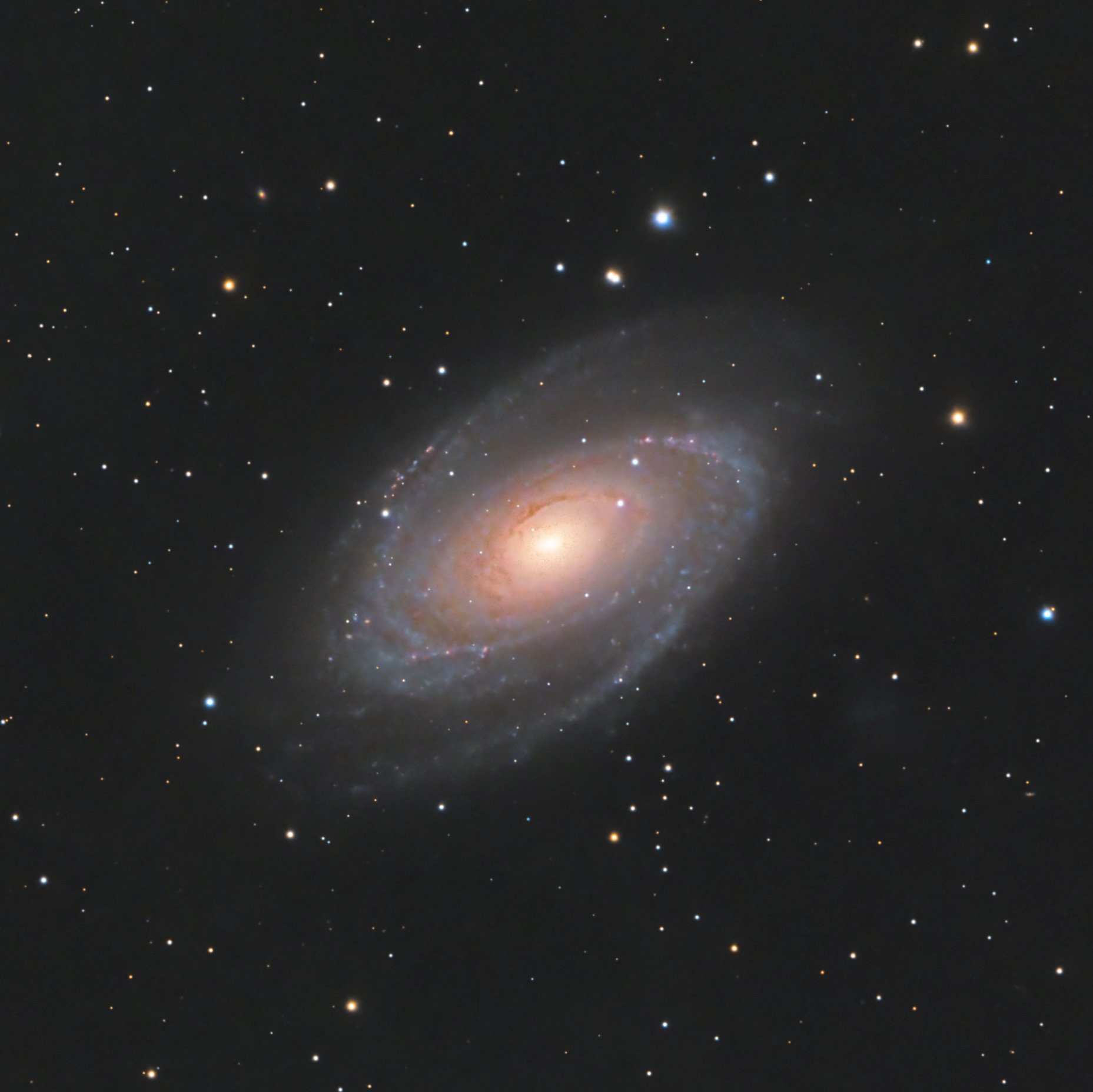The Night Sky - Episode 18
BODE’S GALAXY AND CIGAR GALAXY
This is episode 18 in my series on our night sky
Springtime in the northern hemisphere marks the arrival of a unique and exciting period for amateur astrophotographers — galaxy season. As the night sky transitions from the rich, star-studded winter constellations to the more sparsely populated spring constellations, an array of distant galaxies comes into view. This period offers a prime opportunity to capture stunning images of these enormous star systems. Among the celestial treasures visible during galaxy season, two of the most captivating are Bode’s Galaxy (M81) and the Cigar Galaxy (M82).
Bode’s (M81) and Cigar (M82) galaxies. A total of 217 exposures of 3 minutes each were shot to complete this image. That is about 11 hours of light collected.
Image by Achint Thomas
M81 and M82 are not just beautiful deep-space objects. They are colossal galaxies in the Ursa Major constellation, spanning tens of thousands of light-years each and containing billions of stars. M81, with its grand spiral arms, and M82, with its starburst activity, are among the brightest and most interesting galaxies visible from Earth. Their sheer scale and the fascinating processes occurring within them make them prime targets for astrophotographers and astronomers alike.
M81, commonly known as Bode’s Galaxy, was discovered by Johann Elert Bode in 1774. This grand spiral galaxy is approximately 90,000 light-years in diameter, making it about half the size of our Milky Way. It is estimated to contain 250 billion stars and lies at a distance of around 12 million light-years from Earth.
Closeup of Bode’s Galaxy (M81)
Image by Achint Thomas
M82, or the Cigar Galaxy, gets its name from its elongated, cigar-like shape. It was also discovered by Bode in the same year as M81. While M82 is smaller, measuring about 37,000 light-years across, it is undergoing intense starburst activity, resulting in the formation of new stars at a rate ten times faster than that of a typical galaxy. M82 is estimated to contain 30 billion stars and is also located roughly 12 million light-years away.
Closeup of Cigar Galaxy (M82)
Image by Achint Thomas
Together M81 and M82 forms a striking pair in the night sky.
Locating M81 and M82
Ursa Major, also known as the Great Bear, is one of the most recognizable constellations in the northern sky. It is home to the famous asterism, the Big Dipper, which consists of seven bright stars that form a distinct pattern resembling a pan/bowl or dipper. This asterism is a convenient guide for locating other celestial objects, including M81 and M82.
The Big Dipper is circumpolar in the northern hemisphere. This means it is always visible above the horizon as it revolves around Polaris, the North Star. Since M81 and M82 are close to the Big Dipper, these two galaxies are also circumpolar.
Location of M81 and M82 in the springtime night sky in the northern hemisphere. Polaris (the North Star) can be seen at the center of the frame. It is the point around which all the other stars appear to revolve. M81 can be seen as the tracked red circle close to the constellation of Ursa Major.
Image by Achint Thomas
The Big Dipper's stars have been used in navigation for centuries, with the two stars at the end of the "bowl," Dubhe and Merak, pointing directly to Polaris. This makes Ursa Major a valuable tool for orientation in the night sky.
M81 and M82 can be quickly located using star hopping. Star hopping is a method used by amateur astronomers to locate celestial objects by using bright stars as guideposts.
Star chart showing how to locate M81 & M82 in the night sky. The key is to locate the one of the most famous asterisms in the northern skies — The Big Dipper. This asterism is visible year-round in the northern hemisphere. [image reference]
To find M81 and M82, you can start with the Big Dipper, which is part of Ursa Major.
Identify the Big Dipper: Locate the Big Dipper in the northern sky. Its distinct pan shape makes it relatively easy to find.
Use Dubhe and Phecda: The two stars that form the diagonal across the bowl of the Big Dipper’s bowl are Dubhe (α Ursae Majoris) and Phecda (γ Ursae Majoris). Draw an imaginary line from Phecda through Dubhe and extend it the same distance between these two stars.
Find the Guide Stars: Along this extended line, you will come close to a pair of fainter stars. These stars are located near the area where M81 and M82 reside.
Locate M81 and M82: Look slightly above this line, and you will find M81 and M82. They are close enough together to be seen in the same field of view through a pair of binoculars or a low-power telescope eyepiece.
M81 will appear as a fuzzy oval shape, while M82 will look like a thin, elongated smudge.
A Vast and Wonderful Universe
When we gaze up at the night sky, our eyes are drawn to the brightest stars and the occasional familiar patterns of constellations. In truth, even a tiny fragment of the sky holds hidden treasures that extend beyond what we can see with the naked eye.
The image below shows the portion of the sky around M81 and M82, covering a field of view that is barely 1.5° x 1.5° wide. To put that in context, imagine holding your thumb at arm's length against the night sky. The area covered by your thumbnail will be roughly 1.5° x 1.5° wide! Within this seemingly small patch of darkness, less than 0.5% of the total sky, lies a vast and mind-boggling expanse of the universe.
Annotated image of the region around Bode's Galaxy (M81) and Cigar Galaxy (M82). Each identifier (in cyan) is the location of a galaxy deep in space.
Image by Achint Thomas
In this minuscule field of view lie more than three dozen galaxies, each one an immense collection of stars, gas, and dust, potentially harbouring billions of stars and countless planetary systems. The scale is staggering: what appears to be just a small square of the sky to our naked eyes unveils a breathtaking depth of the cosmos, showcasing the immense variety and number of galaxies spread across the universe. This tiny window into the night sky offers a humbling glimpse into the vastness and richness of the universe, reminding us of the countless wonders that lie beyond our immediate perception.
Historical Discoveries and Modern Understandings
Here is an interesting fact about M81 and M82. Remember that these galaxies were first discovered by Johann Elert Bode in the late 1700s. However, at the time of their discovery, Bode would not have known that these celestial objects were actually galaxies. In the 18th century, the understanding of the universe was still in its infancy, and the concept of galaxies as vast, independent systems of stars was not yet established. Bode thought that he had discovered two ordinary nebulae in space.
It wasn't until the early 20th century that we gained a deeper understanding of the cosmos. In the 1920s, Edwin Hubble provided conclusive evidence that the universe extended beyond our own Milky Way. Hubble's observations of the Andromeda Galaxy and other spiral nebulae showed that these objects were, in fact, separate galaxies, each containing billions of stars. This monumental discovery expanded our view of the universe, revealing that it is filled with countless galaxies, each a massive collection of stars, planets, and other celestial bodies.
Bode's discovery of M81 and M82, once thought to be simple nebulae or star clusters, is now understood to be the identification of two prominent galaxies in our cosmic neighborhood. This historical journey from Bode's initial observations to Hubble's groundbreaking proof illustrates the evolving nature of astronomical knowledge and the ever-expanding boundaries of our understanding of the universe.
Capturing the Two Galaxies
For my project on M81 and M82, I utilized a custom-built astro-imaging train or optical tube assembly (OTA), which included several critical components that together provided the precision and flexibility necessary for capturing detailed astrophotographs. The OTA consists of more than just a camera and lens; it incorporates various elements, each playing a vital role in the imaging process.
My current custom-built OTA for astrophotography. I built this component by component over the course of two years for my specific needs.
Image by Achint Thomas
Telescope/Lens
At the heart of the OTA is the telescope or lens, which serves as the primary optical instrument. For deep-sky astrophotography, telescopes with large apertures and long focal lengths are ideal as they gather more light and provide higher magnification. Refractor telescopes, known for their excellent image quality and minimal maintenance, are often preferred. Reflector telescopes, like Newtonians, offer larger apertures at a lower cost. However, for my project, I used a Sigma 100mm-400mm telephoto camera lens.
Astrocamera
A critical component of the OTA is the astrocamera. Unlike traditional DSLR cameras, astrocameras are specifically designed for astrophotography. They feature highly sensitive sensors capable of capturing faint details of deep-sky objects. Cooled astrocameras, in particular, have a built-in cooling system that reduces thermal noise, resulting in cleaner and more detailed images. For my M81 and M82 project, the ZWO ASI533M Pro cooled astrocamera provided the sensitivity and clarity needed to capture the faint structures of these distant galaxies.
Filter Holder
The filter holder is another essential part of the OTA. It allows the use of various filters to enhance specific features of celestial objects. In my setup, I used a quad-band filter, which combined the benefits of both broadband and narrowband imaging, allowing me to capture detailed images of M81 and M82 even from a slightly light-polluted area.
Guide Scope and Camera
Precise tracking of celestial objects is essential to achieve sharp, long-exposure images. This is where the guide scope comes in. A guide scope is a smaller telescope mounted parallel to the main telescope. Together with an attached guide camera, it tracks a guide star and provides feedback to the mount, ensuring that it adjusts accurately to compensate for the Earth's rotation. This process, known as autoguiding, minimizes star trailing and allows for longer exposure times, which is crucial for capturing faint details in galaxies and other deep-space objects.
Dew Heater
Dew can be a significant issue in astrophotography, as moisture forming on the telescope's lens or mirror can obscure the view. A dew heater prevents this by gently warming the optical surfaces, keeping them free from condensation. This small but crucial device ensures that imaging sessions remain uninterrupted by dew, which is especially important during long exposures needed for deep-sky astrophotography.
Controller
The control computer is the brain of the OTA setup, orchestrating the various components and ensuring they work in harmony. It runs the software that manages the astrocamera, guide camera, and mount, automating tasks like focusing, image capture, and guiding corrections. Advanced software can also integrate with planetarium programs, helping to locate and frame target objects precisely.
Broadband vs. Narrowband Astrophotography
Astrophotography offers a window into the cosmos, allowing us to capture the celestial wonders that adorn the night sky. When capturing a specific deep-space target, one key consideration is choosing between broadband or narrowband imaging techniques.
Broadband astrophotography involves capturing light across a wide range of wavelengths, similar to the visible spectrum the human eye perceives. This method is well-suited for capturing the vibrant colours of celestial objects that emit light across the entire visible spectrum, thereby showcasing their natural hues and characteristics.
On the other hand, narrowband astrophotography focuses on capturing specific wavelengths of light emitted by particular elements or molecules present in nebulae and other cosmic phenomena that emit light in very narrow bands of the electromagnetic spectrum. Astrophotographers can use narrowband filters to isolate the light emitted in these specific wavelengths, thereby greatly minimizing the effect of light pollution.
For my project capturing M81 and M82, I opted for broadband astrophotography because galaxies are broadband targets emitting light across the entire visible spectrum. To enhance the clarity and contrast of my images, I utilized a quad-band filter specifically designed for broadband astrophotography. These innovative filters allow light transmission across four distinct spectral bands, optimizing the capture of red, green, blue, and near-infrared wavelengths while rejecting light from major known artificial light sources like sodium and mercury vapour lamps.
Transmission characteristics of the Optolong L-Quad-Enhance filter — a quad-band filter designed to reduce the effects of light pollution. The peaks in the curve show wavelengths of light that the filter allows to pass, while dips show blocked wavelengths. Notice how the filter blocks wavelengths emitted by Sodium (Na) and Mercury (Hg) vapour lamps. [image reference]
By incorporating a quad-band filter into my OTA, I could accentuate the subtle nuances of the two galaxies’ structure while rejecting city light pollution and maintaining a true-to-life representation of the galaxies’ colours.
Photographing galaxies like M81 and M82 offers a fascinating glimpse into the vastness of our universe. Each galaxy contains billions of stars, countless planetary systems, and potentially myriad life forms. The light from these galaxies has travelled through space for millions of years before reaching our eyes and cameras, providing a window into the distant past and the immense scale of the cosmos. Through astrophotography, we can connect with the cosmos in a deeply meaningful way, gaining a greater appreciation for the wonders that lie beyond our own planet.
Check out some other galaxies I have captured.
Capture details
Camera: ZWO ASI 533MC Pro
Gain: 100
Sensor Temperature: -20°C
Lens: Sigma 100-400mm f/5-6.3 DG OS HSM
Focal length: 400mm (equivalent of 1080mm full-frame)
f-Ratio: 6.3
Sub-exposure length: 180 seconds
Number of exposures: 217 (with the Optolong L-Quad-Enhance filter)
Total integration time: 10.8 hours
Calibration frames: 30 darks, 30 flats, 30 dark flats
Mount: SkyWatcher Star Adventurer GTi
Guide camera: ZWO 120mm mini
Guide scope: ZWO Mini Guide scope
Capture control: ZWO ASIAir Pro
Dew control: SvBony dew heater
Field Power: AIMTOM 194Wh Portable Power Station
Sky quality: Bortle 5
Moon phase: 75% to 100%
Processing: PixInsight









